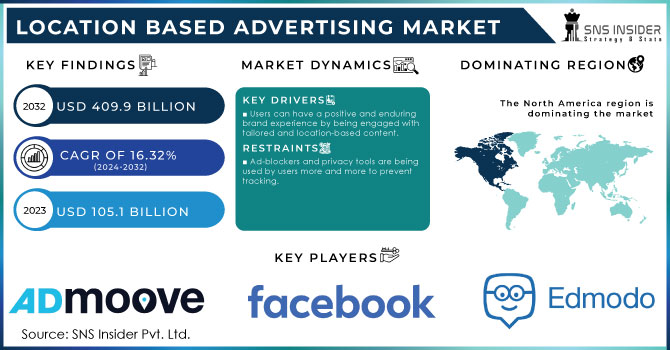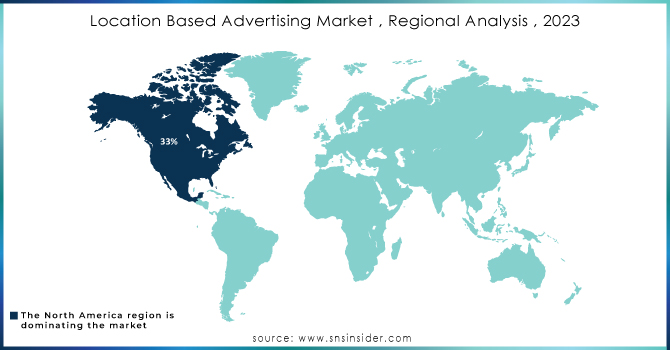Location Based Advertising Market Report Scope & Overview:
The Location Based Advertising Market size was USD 104.01 billion in 2023 and is expected to Reach USD 373.11 billion by 2032 and grow at a CAGR of 15.26% over the forecast period of 2024-2032.
Using information about a user's recent or present location, location-based advertising (LBA) targets users with appropriate ads and marketing materials. In order to deliver more individualized and contextually relevant adverts, this advertising strategy makes advantage of the geographic information collected from consumers' mobile devices or other location-tracking technologies. Users must first give permission for applications or services to access their location data in order for location-based advertising to function.

Get More Information on Location Based Advertising Market - Request Sample Report
This is normally done either through particular location permissions settings on the user's device or during the app installation process. Once the user has given permission, the program may locate the user accurately or roughly by using a variety of location technologies, including GPS, Wi-Fi, Bluetooth, or cell tower triangulation. Additionally, the use of LBA has increased across industries as a result of consumer usage of social media growing and marketers switching from traditional banner advertising to digital platforms. Additionally, the development of new data sources, regulatory measures to guarantee consumer safety, and altering marketing methodology are anticipated to encourage market expansion. Location data has emerged as one of the most significant data sources since more than two-thirds of the world's population are now connected via GPS-enabled mobile devices. According to the GSMA, there are currently 5.16 billion mobile subscribers worldwide. there are 4.57 billion internet users. The industry insights suggest that three out of four people who search for products or services nearby using their phone generally visit the location the same day and about 25% of those searches lead to confirm purchases. A compelling opportunity for advertisers to post marketing and advertising content on various social media platforms has also arisen as a result of changing consumer behaviour toward the usage of mobile applications for social interaction and purchasing. In addition, the growing number of mobile applications that businesses and advertisers are creating thanks to LBS are probably going to attract more customers and accelerate market expansion.
MARKET DYNAMICS
KEY DRIVERS
-
The rapidly rising digitalization across industry verticals, growing penetration of internet & GPS-enabled mobile devices, and growing use of consumer data by marketers.
-
Users can have a positive and enduring brand experience by being engaged with tailored and location-based content.
The efficiency and accuracy of LBA have been enhanced by ongoing developments in location tracking technology, including better GPS accuracy, beacon technology, and Wi-Fi positioning systems.
RESTRAIN
-
Ad-blockers and privacy tools are being used by users more and more to prevent tracking.
-
Data Accuracy and Reliability
Ad-blockers and privacy tools are being used more frequently by users to prevent tracking and ad targeting, which can reduce the efficiency of location-based advertising.
OPPORTUNITY
-
It is projected that increased use of Cell ID positioning in the wake of growing IoT devices and 5G adoption will support the expansion of location-based services.
-
Location-based advertising is provide Opportunity for local businesses, as it helps drive foot traffic and attract nearby customers.
Marketers, researchers, regulatory organizations, and network providers will have several opportunities to enter the location-based advertising industry as a result of these advancements.
CHALLENGES
-
Obtaining clear and informed consent from users for location tracking can be challenging
It can be difficult to get consumers' clear, informed consent for location tracking. For users who do not want to engage in location-based advertising, app developers and advertisers must offer clear information about data collecting procedures and simple opt-out options.
IMPACT OF RUSSIAN UKRAINE WAR
The location-based advertising (LBA) sector in India and other nations has been significantly impacted by the Russia-Ukraine conflict. the expansion of the Indian location-based advertising market in 2023 is predicted to be negatively impacted by the Russia-Ukraine conflict. It is anticipated that the conflict will result in lower advertising expenditures, a move to internet advertising, and an increase in demand for advertising that respects consumer privacy. These elements are anticipated to counteract the increase that would have been fuelled by the rising popularity of location-based services and the desire for mobile advertising. The Indian location-based advertising market expanded by 10% year over year in the first quarter of 2023. The need for mobile advertising has grown, and location-based services are becoming more and more well-liked, which has contributed to this expansion. Conflict has led to decreased spending on advertising, as businesses have cut back on marketing and promotional activities. This is likely to have a negative impact on the LBA market, as businesses may reduce or eliminate their use of location-based advertising. In the United States, the location-based advertising market grew by 5% year-over-year in the 2023. This growth was driven by the increased demand for mobile advertising and the growing popularity of location-based services.
IMPACT OF ONGOING RECESSION
As a result of firms' reductions in marketing and promotional efforts, the ongoing recession is predicted to result in lower spending on advertising. As a result, firms may employ location-based advertising less frequently or not at all, which would be detrimental to the LBA industry. Several instances of businesses impacted by the ongoing recession in the LBA market, including Foursquare Users can check into places and share their locations with friends using the location-based social networking tool Foursquare. Due to businesses cutting back on spending on advertising, Google Maps, Facebook, and Twitter, Foursquare's revenue has decreased in recent quarters. Due to the crisis and businesses' cuts, these advertising revenues have decreased in recent quarters as well. on their spending on advertising. The ongoing recession is also expected to have a negative impact on the growth of the location-based advertising market in the United States and Europe in 2023.
KEY MARKET SEGMENTATION
By Type
-
Push
-
Pull
By Application
-
Retail Outlets
-
Public Spaces
-
Airports
-
Others
By Content
-
Text
-
Multimedia
By End-User
-
Automobiles
-
Logistics
-
BFSI
-
Real Estate
-
Hospitality
-
Transportation
-
Retail
-
Others
Region Coverage
North America
-
USA
-
Canada
-
Mexico
Europe
-
Eastern Europe
-
Poland
-
Romania
-
Hungary
-
Turkey
-
Rest of Eastern Europe
-
-
Western Europe
-
Germany
-
France
-
UK
-
Italy
-
Spain
-
Netherlands
-
Switzerland
-
Austria
-
Rest of Western Europe
-
Asia Pacific
-
China
-
India
-
Japan
-
South Korea
-
Vietnam
-
Singapore
-
Australia
-
Rest of Asia Pacific
Middle East & Africa
-
Middle East
-
UAE
-
Egypt
-
Saudi Arabia
-
Qatar
-
Rest of Middle East
-
-
Africa
-
Nigeria
-
South Africa
-
Rest of Africa
-
Latin America
-
Brazil
-
Argentina
-
Colombia
-
Rest of Latin America
REGIONAL ANALYSIS
North America accounted for the largest revenue share of over 33% in 2019. to the early adoption of location-based services and advertising solutions, the main factors driving the expansion of the regional LBA market include the presence of well-known vendors in the area, including Google LLP and Facebook Inc. Additionally, in 2018, Google LLP and Facebook Inc. accounted for roughly 56.8% of all digital ad income in the United States. Additionally, as of 2019, almost 84% of all Americans used the internet, and about 60% of them used social media. Therefore, it is projected that a high rate of digitalization across industries, an increase in social media users, and an increase in LBS providers will support the expansion of the LBA market in the area. The North American market emphasized data-driven advertising, and LBA provided valuable insights into consumer behaviour and preferences, enabling advertisers to create more targeted and effective campaigns. Also, the region was at the forefront of mobile technology innovations, driving the adoption of location-based technologies and applications.
The Asia Pacific area will be expected to experience the fastest growth during the anticipated timeframe. One of the main drivers of market growth is the rise in smartphone usage, as well as rising e-commerce platform spending on products and services and low-cost advertising models. The APAC region has a vast mobile-first population, and mobile devices are the primary means of internet access for many users. This trend contributed to the effectiveness and reach of LBA campaigns. More than 57% of the firms in the region studied are expected to boost their investment in digital advertising for 2020, according to the 2020 Digital Trends in Asia Pacific. Furthermore, the expansion of significant LBS providers like Near Pte Ltd, a location-based mobile advertising platform in Singapore, has been crucial in reaching out to countries like Malaysia and Indonesia.

Do You Need any Customization Research on Location Based Advertising Market - Enquire Now
KEY PLAYERS
The major players in the Location Based Advertising Market are AdMoove, Emodo (Placecast), Facebook Inc., Foursquare, Google Inc., Ground Truth, IBM Corporation, Near Pte Ltd., Proximus, Mobility, LLC., and other players.
RECENT DEVELOPMENTS
Foursquare: On March 8, 2023, Foursquare, a location-based social networking service, announced a new location-based advertising platform. The new platform, called Swarm, allows businesses to target their ads to users based on their location, interests, and behaviour.
Google Maps: On May 20, 2023, Google Maps, a location-based service, integrated with Waze, a navigation app, the integration allows businesses to target their ads to users who are using either Google Maps or Waze.
| Report Attributes | Details |
| Market Size in 2023 | US$ 104.01 Bn |
| Market Size by 2032 | US$ 372.11 Bn |
| CAGR | CAGR of 15.26 % From 2024 to 2032 |
| Base Year | 2023 |
| Forecast Period | 2024-2032 |
| Historical Data | 2020-2022 |
| Report Scope & Coverage | Market Size, Segments Analysis, Competitive Landscape, Regional Analysis, DROC & SWOT Analysis, Forecast Outlook |
| Key Segments | • By Type (Push, Pull) • By Application (Retail Outlets, Public Spaces, Airports, Others) • By Content (Text, Multimedia) • By End-User (Automobiles, Logistics, BFSI, Real Estate, Hospitality, Transportation, Retail, Others) |
| Regional Analysis/Coverage | North America (US, Canada, Mexico), Europe (Eastern Europe [Poland, Romania, Hungary, Turkey, Rest of Eastern Europe] Western Europe] Germany, France, UK, Italy, Spain, Netherlands, Switzerland, Austria, Rest of Western Europe]). Asia Pacific (China, India, Japan, South Korea, Vietnam, Singapore, Australia, Rest of Asia Pacific), Middle East & Africa (Middle East [UAE, Egypt, Saudi Arabia, Qatar, Rest of Middle East], Africa [Nigeria, South Africa, Rest of Africa], Latin America (Brazil, Argentina, Colombia Rest of Latin America) |
| Company Profiles | AdMoove, Emodo (Placecast), Facebook Inc., Foursquare, Google Inc., Ground Truth, IBM Corporation, Near Pte Ltd., Proximus, Mobility, LLC. |
| Key Drivers | • The rapidly rising digitalization across industry verticals, growing penetration of internet & GPS-enabled mobile devices, and growing use of consumer data by marketers. • Users can have a positive and enduring brand experience by being engaged with tailored and location-based content. |
| Market Opportunities | • It is projected that increased use of Cell ID positioning in the wake of growing IoT devices and 5G adoption will support the expansion of location-based services. • Location-based advertising is provide Opportunity for local businesses, as it helps drive foot traffic and attract nearby customers. |

